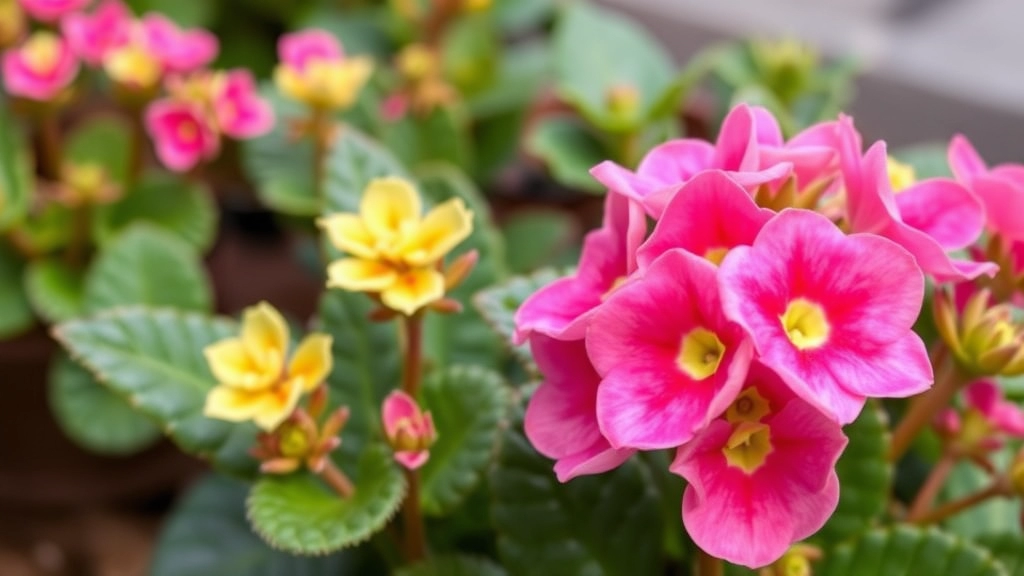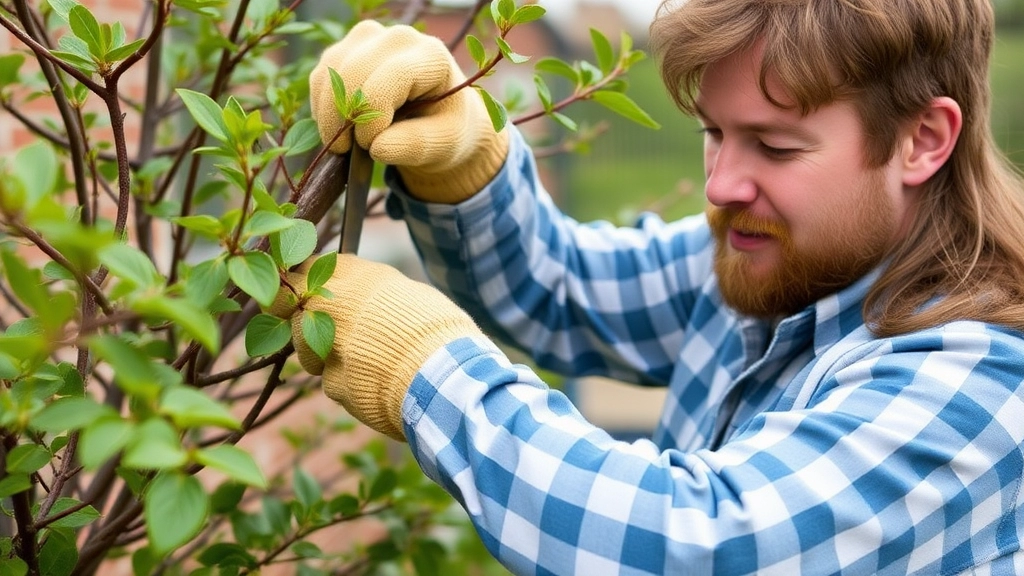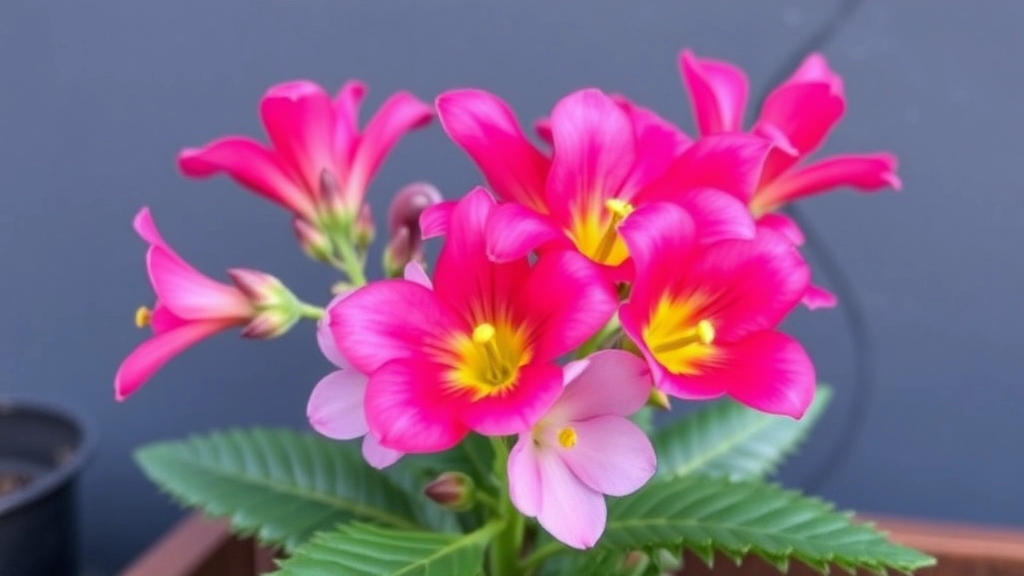Kalanchoe Blossfeldiana Growth
When it comes to Kalanchoe Blossfeldiana growth, understanding the optimal conditions is key. This vibrant succulent thrives in bright, indirect light and well-draining soil. Ensuring these conditions will help your Kalanchoe Blossfeldiana flourish, whether you’re growing it indoors or outdoors.
Watering and Feeding Practices
Proper watering and feeding practices are crucial for healthy growth. Water your Kalanchoe Blossfeldiana thoroughly but allow the soil to dry out between waterings. Overwatering can lead to root rot, so it’s essential to strike the right balance. Additionally, feeding your plant with a balanced fertiliser every few months will promote robust growth and vibrant blooms.
Optimal Conditions for Kalanchoe Blossfeldiana Growth
Are you struggling to keep your Kalanchoe Blossfeldiana thriving?
Understanding the optimal conditions for its growth can make a world of difference.
Light Requirements
Kalanchoe Blossfeldiana thrives in bright, indirect sunlight.
- Aim for at least 6 hours of light daily.
- Too much direct sunlight can scorch the leaves, while too little can stunt growth.
Temperature
This plant prefers a warm environment.
- Ideal temperatures range from 18°C to 24°C.
- Avoid exposing your Kalanchoe to temperatures below 10°C, as it can lead to stress and poor health.
Humidity
Kalanchoe Blossfeldiana is quite adaptable but prefers moderate humidity levels.
- A humidity level of around 40-60% is ideal.
- If your home is particularly dry, consider using a humidity tray or a room humidifier.
Soil Type
Choosing the right soil is crucial for healthy growth.
- Use a well-draining potting mix, ideally one designed for succulents.
- Adding perlite or sand can enhance drainage and prevent root rot.
Potting and Location
The right pot and placement can significantly affect growth.
- Ensure your pot has drainage holes to prevent water accumulation.
- Place your Kalanchoe in a location where it can receive ample light without being exposed to harsh conditions.
Best Practices for Watering and Feeding Kalanchoe Blossfeldiana

So, you’ve got your Kalanchoe Blossfeldiana all set up, but how do you keep it thriving? Watering and feeding are key, and getting it right can make a world of difference.
Watering Tips:
- Check the Soil: Before you water, poke your finger about an inch into the soil. If it feels dry, it’s time to give it a drink. If it’s still moist, hold off for a bit.
- Watering Schedule: Generally, Kalanchoes prefer to dry out between waterings. In the warmer months, every two weeks should do. In winter, you can stretch it to once a month.
- Avoid Overwatering: These plants hate soggy roots. Make sure your pot has drainage holes. If water collects at the bottom, it’s time to repot or change your watering habits.
- Use Room Temperature Water: Cold water can shock the plant. Stick to room temperature for a more comfortable drink.
Feeding Your Kalanchoe:
- Fertilise Sparingly: During the growing season (spring and summer), use a balanced, water-soluble fertiliser every 4-6 weeks. Too much can lead to leggy growth.
- Choose the Right Fertiliser: Look for one that’s high in potassium. This helps with blooming and overall health.
- Cut Back in Winter: Your Kalanchoe doesn’t need much food in the colder months, so ease off on the fertiliser.
Quick Recap:
- Check soil moisture before watering.
- Water every 2 weeks in summer, once a month in winter.
- Use room temperature water.
- Fertilise every 4-6 weeks during the growing season with a potassium-rich fertiliser.
Propagation Techniques for Kalanchoe Blossfeldiana
Are you looking to expand your Kalanchoe Blossfeldiana collection? Propagation is a rewarding and straightforward process that can help you achieve just that.
Methods of Propagation
- Leaf Cuttings
- Select a healthy leaf from the parent plant.
- Allow the cut end to callous over for a few days.
- Place the leaf in well-draining soil and water lightly.
- Keep it in a warm, bright location.
- Roots should develop within a few weeks.
- Stem Cuttings
- Cut a healthy stem, ideally around 4-6 inches long.
- Remove the lower leaves to expose the nodes.
- Let the cut end dry for a day or two.
- Plant it in soil, ensuring the nodes are buried.
- Water sparingly and place in indirect sunlight.
- Offsets
- Kalanchoe often produces offsets or “pups” around the base.
- Gently separate these from the parent plant.
- Replant them in their own pots with well-draining soil.
- Water lightly until they establish roots.
Tips for Successful Propagation
- Timing: Spring is the best season for propagation, as the plant is actively growing.
- Soil: Use a cactus or succulent mix for optimal drainage.
- Humidity: Maintain a humid environment by covering cuttings with a plastic bag or using a humidity dome.
Pruning and Maintaining Healthy Growth

As we transition from understanding the optimal conditions for Kalanchoe Blossfeldiana, let’s delve into the importance of pruning and maintaining healthy growth for these vibrant plants.
Why Pruning Matters
Pruning is essential for Kalanchoe Blossfeldiana to thrive. It encourages new growth, helps maintain shape, and prevents overcrowding.
Here are some key reasons why you should consider pruning:
- Promotes Air Circulation: Helps reduce the risk of fungal diseases.
- Encourages Blooming: Stimulates the plant to produce more flowers.
- Removes Dead or Diseased Leaves: Keeps the plant healthy and aesthetically pleasing.
When to Prune
Timing is crucial when it comes to pruning. The best time to prune Kalanchoe Blossfeldiana is:
- After Flowering: Once the blooming period is over, usually in late spring or early summer.
- During Active Growth: This ensures the plant can recover quickly.
How to Prune
Follow these simple steps to prune your Kalanchoe Blossfeldiana effectively:
- Use Clean, Sharp Tools: This prevents the spread of disease.
- Identify Dead or Weak Stems: Remove them at the base to encourage new growth.
- Trim Excess Foliage: Aim for a balanced shape while ensuring air can circulate freely.
- Be Gentle: Avoid cutting too much at once to prevent shock.
Maintaining Healthy Growth
Beyond pruning, maintaining healthy growth involves several practices:
- Monitor Watering: Ensure the plant is neither overwatered nor underwatered.
- Provide Adequate Light: Place in bright, indirect sunlight to encourage robust growth.
- Fertilise Sparingly: Use a balanced fertiliser during the growing season, but avoid over-fertilising.
Common Pests and How to Prevent Them
As we delve into the essential care of Kalanchoe Blossfeldiana, it’s crucial to address the challenges posed by pests. Many plant lovers worry about infestations that can harm their beloved Kalanchoe.
Identifying Common Pests
Kalanchoe can fall victim to several pests, including:
- Aphids: Small, green or black insects that cluster on new growth.
- Mealybugs: White, cottony pests that hide in leaf axils.
- Spider Mites: Tiny, spider-like creatures that leave fine webs and yellow spots on leaves.
- Scale Insects: Brown, shell-like pests that attach themselves to stems and leaves.
These pests can quickly become a nuisance, but with the right preventive measures, you can keep your Kalanchoe thriving.
Prevention Strategies
To protect your Kalanchoe from these unwelcome guests, consider the following strategies:
- Regular Inspection: Check your plants weekly for signs of pests. Early detection is key.
- Maintain Cleanliness: Keep the surrounding area free of fallen leaves and debris, which can attract pests.
- Optimal Air Circulation: Ensure your plant has adequate airflow to reduce humidity, making it less inviting for pests like spider mites.
- Natural Predators: Introduce beneficial insects like ladybugs, which can help control pest populations.
- Neem Oil: Use neem oil as a natural pesticide. Spray it on your plants every few weeks to deter pests without harming the plant.
Managing Infestations
If you spot pests, act quickly to manage the situation:
- Isolation: Move affected plants away from others to prevent the spread of pests.
- Manual Removal: For minor infestations, wipe off pests with a damp cloth or use a soft brush.
- Insecticidal Soap: Apply insecticidal soap to affected areas, following the manufacturer’s instructions.
By incorporating these preventive measures, you can safeguard your Kalanchoe Blossfeldiana from pests, ensuring it remains healthy and vibrant.
FAQs on Kalanchoe Blossfeldiana Growth
How often should I water my Kalanchoe Blossfeldiana?
Generally, Kalanchoe Blossfeldiana prefers to dry out between waterings. In the warmer months, watering every two weeks is sufficient. During winter, you can stretch it to once a month.
What type of water should I use for my Kalanchoe Blossfeldiana?
It’s best to use room temperature water. Cold water can shock the plant, which can be detrimental to its health.
How do I know when to water my Kalanchoe Blossfeldiana?
Check the soil moisture by poking your finger about an inch into the soil. If it feels dry, it’s time to water. If it’s still moist, wait a bit longer before watering.
What kind of fertiliser should I use for my Kalanchoe Blossfeldiana?
During the growing season (spring and summer), use a balanced, water-soluble fertiliser every 4-6 weeks. Opt for a fertiliser that’s high in potassium to help with blooming and overall health.
Should I fertilise my Kalanchoe Blossfeldiana in winter?
No, you should cut back on fertilising during the colder months as the plant doesn’t need much food during this period.
Why is pruning important for Kalanchoe Blossfeldiana?
Pruning encourages new growth, helps maintain the plant’s shape, and prevents overcrowding. It also promotes air circulation, reduces the risk of fungal diseases, and stimulates more blooming.
When is the best time to prune Kalanchoe Blossfeldiana?
The best time to prune is after the flowering period, usually in late spring or early summer, and during active growth to ensure the plant can recover quickly.
How should I prune my Kalanchoe Blossfeldiana?
Use clean, sharp tools to prevent disease spread. Identify and remove dead or weak stems at the base, trim excess foliage for a balanced shape, and avoid cutting too much at once to prevent shock.
What are some best practices for maintaining healthy growth in Kalanchoe Blossfeldiana?
Monitor watering to ensure the plant is neither overwatered nor underwatered, provide adequate light (bright, indirect sunlight), and fertilise sparingly during the growing season.
How can I avoid overwatering my Kalanchoe Blossfeldiana?
Make sure your pot has drainage holes to prevent soggy roots. If water collects at the bottom, consider repotting or adjusting your watering habits.
References
-
Kalanchoe Care: Growing And Caring For Kalanchoe Plants
-
How to Grow and Care for Kalanchoe
-
Kalanchoe: How to Grow and Care for Kalanchoe
